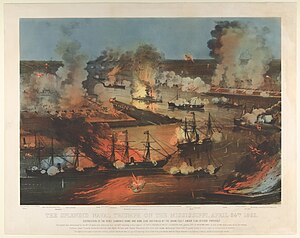
USS Brooklyn was a sloop-of-war authorized by the U.S. Congress and commissioned in 1859. Brooklyn was active in Caribbean operations until the start of the American Civil War at which time she became an active participant in the Union blockade of the Confederate States of America.

The First Battle of Memphis was a naval battle fought on the Mississippi River immediately north of the city of Memphis, Tennessee on June 6, 1862, during the American Civil War. The engagement was witnessed by many of the citizens of Memphis. It resulted in a crushing defeat for the Confederate forces, and marked the virtual eradication of a Confederate naval presence on the river. Despite the lopsided outcome, the Union Army failed to grasp its strategic significance. Its primary historical importance is that it was the last time civilians with no prior military experience were permitted to command ships in combat. As such, it is a milestone in the development of professionalism in the United States Navy.

Laurent Millaudon was a wooden side-wheel river steamboat launched at Cincinnati, Ohio, in 1856 operating in the New Orleans, Louisiana, area, and captained by W. S. Whann. At the beginning of the American Civil War she was taken into service by the Confederate Navy as CSS General Sterling Price. On 6 June 1862, she was sunk at the First Battle of Memphis. She was raised and repaired by the Union army, and on 16 June 1862 was moved into Union service as USS General Price and served until the end of the war.

The Battle of Plum Point Bend took place in Tennessee during the American Civil War on May 10, 1862, on the Mississippi River, between ships of the Confederate River Defense Fleet and the Union Western Flotilla. Fighting for control of the Mississippi had been ongoing since the prior year as Union forces pushed downriver to Fort Pillow, about 50 miles (80 km) north of Memphis. The Union had been using mortar boats to bombard Fort Pillow, and had settled into a regular routine. The Union's daily tactic was to send a single mortar boat guarded by an ironclad warship to a position further downriver to shell the fort, while the rest of the fleet remained upriver. On the morning of May 10, the Confederates attacked in the hope of capturing the guard ironclad and then surprising the rest of the Union fleet.

The capture of New Orleans during the American Civil War was a turning point in the war that precipitated the capture of the Mississippi River. Having fought past Forts Jackson and St. Philip, the Union was unopposed in its capture of the city itself.
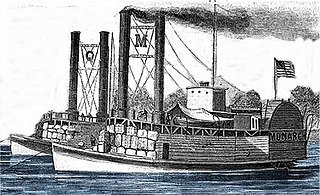
USS Monarch was a United States Army sidewheel ram that saw service in the American Civil War as part of the United States Ram Fleet and the Mississippi Marine Brigade. She operated on the Mississippi River and Yazoo River during 1862 and 1863.

The battle of Forts Jackson and St. Philip was the decisive battle for possession of New Orleans in the American Civil War. The two Confederate forts on the Mississippi River south of the city were attacked by a Union Navy fleet. As long as the forts could keep the Federal forces from moving on the city, it was safe, but if they fell or were bypassed, there were no fall-back positions to impede the Union advance.
CSS Jackson was a gunboat of the Confederate Navy during the American Civil War.

CSS General Earl Van Dorn was a cottonclad warship used by the Confederate States of America during the American Civil War. She was purchased for Confederate service in New Orleans, Louisiana, in early 1862 to serve with the River Defense Fleet. She was converted into a cottonclad warship by installing an iron-covered framework of timbers on her bow that served as a ram, and protecting her machinery with timber bulkheads packed with cotton. A sidewheel steamer, she was 182 feet (55 m) long and was armed with a single 32-pounder cannon on the bow.

CSS Colonel Lovell was a cotton-clad ram ship of the Confederate States Navy during the American Civil War

Mansfield Lovell was a major general in the Confederate States Army during the American Civil War. As military commander of New Orleans when the city unexpectedly fell to the Union Navy in 1862, Lovell was fiercely criticized by local citizens for failing to predict a naval invasion. The Confederate government also heaped blame on him, to deflect attention from their own error in leaving so few troops to defend the city. A Court of Enquiry later cleared him of charges of incompetence, but his reputation never recovered.

CSS Stonewall Jackson was a cottonclad sidewheel ram of the Confederate Navy during the American Civil War.
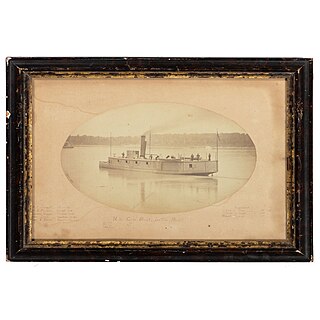
Little Rebel was a cotton-clad ram that had been converted from a Mississippi River steamer to serve as the flagship of the Confederate River Defense Fleet in the American Civil War. Sent from New Orleans to defend against the Federal descent of the Mississippi, she was among the force that engaged vessels of the Union Army's Western Gunboat Flotilla at the Battle of Plum Point Bend on May 10, 1862. On June 6, she again was involved in an action with the Federal gunboats, this time at the First Battle of Memphis. In the battle, a shot from a Federal gun pierced her boiler, disabling her, and she was then pushed aground by the Federal ram USS Monarch and captured.

USS Maria J. Carlton was a schooner acquired by the United States Navy on October 15, 1861, during the American Civil War. Built before the war, the vessel was converted into a mortar schooner by the Navy. She was then transferred to the mouth of the Mississippi River in early 1862, as part of a force tasked with neutralizing Confederate forts guarding New Orleans, Louisiana. Maria J. Carlton participated in the Battle of Forts Jackson and St. Philip on April 18, but, the battle continuing, was sunk the next day by a shot from Fort Jackson. She was the only Union warship sunk solely by artillery fire from Confederate forts on the Mississippi River during the war.
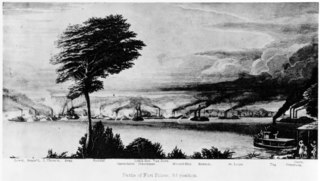
USS Sumter was a 525-ton sidewheel paddle steamer captured by the Union Navy during the Union blockade of the American Civil War.

The River Defense Fleet was a set of fourteen vessels in Confederate service, intended to assist in the defense of New Orleans in the early days of the American Civil War. All were merchant ships or towboats that were seized by order of the War Department in Richmond and converted into warships by arming each with one or two guns, protecting their engines by an interior bulkhead, and strengthening their bows so they could be used as rams. Although they were nominally a part of the Confederate States Army, all of their officers and most of their crews were civilians. A portion of the fleet was retained in the south part of the Mississippi River and a portion was sent north to defend against Union movement from the north.
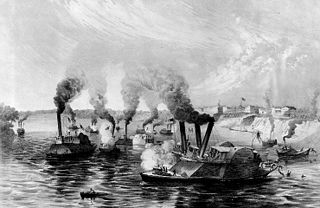
CSS General Beauregard was a cottonclad sidewheel ram of the Confederate States Navy during the American Civil War.

CSS General M. Jeff Thompson was a warship which served in the River Defense Fleet of the Confederate States of America during the American Civil War. Purchased in January 1862, the vessel was operated by the Confederate States Army and named after M. Jeff Thompson, an officer in the Missouri State Guard. She was equipped with a ram and armored as a cottonclad. General M. Jeff Thompson participated in the Battle of Plum Point Bend in May 1862, before being sunk on June 6 in the First Battle of Memphis. Her wreck remained on the floor of the Mississippi River until it was removed by a snagboat in July 1867; it had caused a shipwreck about six months earlier when another vessel struck it.

The Battle of the Head of Passes was a bloodless naval battle of the American Civil War. It was a naval raid made by the Confederate river defense fleet, also known as the “mosquito fleet” in the local media, on ships of the Union blockade squadron anchored at the Head of Passes. The mosquito fleet deployed three fire rafts, which were ignited and followed the ironclad ram CSS Manassas into the action. The attack occurred after moonset in the early hours of October 12, 1861, and routed the Union fleet, which fled in disorder down the Southwest pass of the delta. After sunrise Commodore George N. Hollins, running low on ammunition and fuel, ordered the mosquito fleet to withdraw upriver.
Defiance, a high-pressure steamer, was built at Cincinnati, Ohio, in 1849. She was purchased for the Confederate Army, probably from the Southern Steamship Co., New Orleans, La., in the latter part of 1861. Capt. J. E. Montgomery, a former river steamboat captain, selected her to be part of his River Defense Fleet. On January 25, 1862, he began to convert her into a cottonclad ram by placing a 4-inch oak sheath with a one-inch iron covering on her bow, and by installing double pine bulkheads filled with compressed cotton bales.
